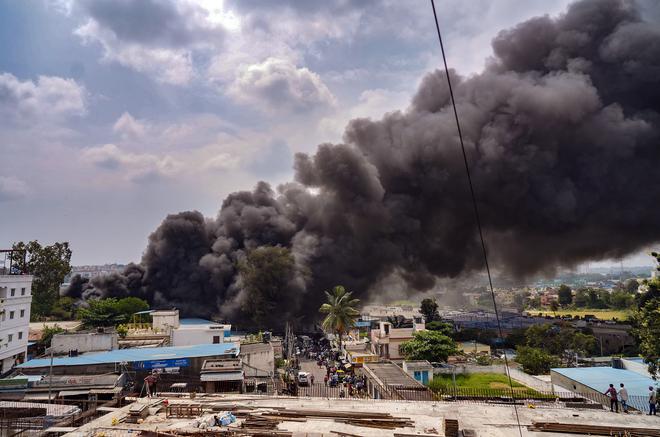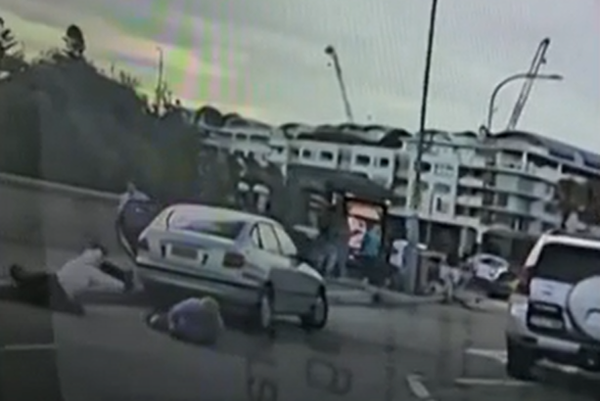A dangerous 12% annual spike in fire accidents in Bengaluru has shifted the spotlight back on the need for stringent enforcement of fire safety regulations. An accelerated vertical push, symbolised by the mushrooming high-rises across the city has injected a sense of urgency. This, when blatant violations in building plans continue to block quick access to fire-fighting men and machines.
Making a mockery of clearly laid out safety precautions, commercial establishments, godowns, cracker units, and rooftop pubs have all become vulnerable to fire accidents. Non-functional fire extinguishers, incendiary material in store rooms, blocked fire exits, lack of adequate setbacks for quick entry of fire-fighting trucks… The list is long.
A recent fire safety audit by the Karnataka Fire and Emergency Services exposed the enormity of the violations. As many as 243 rooftop restaurants were flagged, a clear indication that the thousands who frequent these places were risking their lives in case of a blaze. The message is disturbing: Despite the recurring accidents, no lessons have been learnt.
Tricky scale-up of high rise height
The change in rules could make things even more risky. Till the middle of this year, buildings measuring 15 metres and taller were defined as high-rises. This meant they had to obtain a fire licence, renewed after a re-inspection by the Fire Department every two years. But a bill passed by the Karnataka Legislative Assembly in July has increased the height to 25 metres.
Justifying the decision, Home Minister G. Parameshwara said it was as per the National Building Code (NBC) of 2016. It is now mandatory for buildings 25 metres and above to obtain a No Objection Certificate (NOC). However, it is uncertain how this will ensure the fire safety of buildings below 25 metres and above 15 metres that house several pubs and restaurants.
Fire safety rules were amended and re-inspection of high-rises (15m and above) mandated following a Public Interest Litigation (PIL) filed by Beyond Carlton, a city-based collective and Namma Bengaluru Foundation in 2011. The trigger was the Carlton Towers fire accident on February 23, 2010, which claimed nine lives and left over 70 injured.

Costly re-inspection
However, re-inspection has become a costly affair as the building owners and apartment associations are asked to bear the high expense involved. The Fire Department says it has inadequate staff to undertake detailed re-inspections.
Uday Vijayan, co-founder of Beyond Carlton agrees that there is a pushback from apartment associations. “The re-inspection cost is substantial. It is in the range of ₹2 lakh, which is a challenge to many. In some States such as Uttar Pradesh, they don’t charge a fee since it is seen as a safety requirement for people,” he notes.
The latest spike in fire accidents in the city has forced the Government to propose a plan to boost the Fire Department staff strength. Director General of Police, Fire and Emergency Services, Kamal Pant recently announced an action plan in the works to prevent accidents. Augmenting the fire brigade and building new fire stations in and around the city is on the plan agenda.
“Once in two-year inspection is an eyewash imposed on apartments by the fire department. It is just a sham, more of a money-making racket than a genuine concern for fire safety in apartment complexes,” says Bengaluru Apartments Federation (BAF) Founder Srikant Narasimhan. “If bribes are paid, things are set right. How does it improve fire safety,” he wonders.
Bulk of the fire safety requirements in residential apartments can be fulfilled if the security guards and estate managers are trained, says Srikant. “But there are two areas that can be improved. There should be no impediments in the common areas. The terrace door should not be locked like they do in many complexes. In case of fire, one mode of exit is to rush to the terrace. Many associations still don’t have an understanding of the risks. That awareness needs to improve,” he elaborates.
Clearing the roads
Fire safety, as Uday reminds, is also about multi-agency coordination. He recalls how in 2010, fire trucks were trapped in the heavy Old Airport Road traffic. “A senior fire department official was telling me how all his fire engines were stranded, and he had to bang on virtually every car to move out of the way. In 2010, there was far less traffic than today,” he points out.
It was then a Command Centre was set up to facilitate seamless movement of fire trucks. “One fire department is always seated in the Centre, coordinated with the city traffic police to clear out the roads. On paper, there is better coordination now. But the reality depends on that particular day,” says Uday.
The mushrooming of unregulated layouts, particularly on the city’s outskirts, has made it tougher today. Most such residential/commercial clusters are served by narrow roads, encroached upon from either side. While both Srikant and Uday agree that the newer apartments constructed by reputed builders have all the fire-fighting systems and the required setbacks, the older buildings are often without even the mandatory safety equipment.
Vertical push and ladders
But the vertical push could pose new challenges. Last year, the Fire Department had acquired a 90-metre aerial ladder platform vehicle for the city. Many more of it would be required, with the Transit Oriented Development (TOD) around mass transit corridors giving a boost to the city’s high-rise growth. “If you have a 30-storey building, it is unlikely you can blow out a fire from outside at that height. The fire has to be fought internally first before the firemen get there,” says Uday.
Suresh Hari, Secretary (Karnataka) of the Confederation of Real Estate Developers’ Associations of India (CREDAI) says old buildings will have to be retrofitted with robust fire-fighting equipment. “As for setbacks, it is the government’s job to monitor it. The building plan sanctioning authority should also look into it,” he says.
Beyond regular mock fire drills, many new apartments are fitted with water tanks specifically meant for fire-fighting. Water in these tanks are refilled at least once in six months, and flows through an elaborate system of pipelines attached to different levels. However, this is yet to be standardized.
Time for Fire Blueprint
In 2018, Beyond Carlton had come out with a Fire Safety Blueprint for Bengaluru, focused on capacity-building, regulations and compliance and awareness. The key recommendations were to formulate a retrofit policy for older buildings, link property tax payment to issue of No Objection Certificates (NOCs), a Public Private Partnership (PPP) to build and monitor new fire stations, mandatory burn wards in hospitals and sound protocols for inter-agency coordination.
The Blueprint had a clear target: Zero fire accident deaths by 2023 and a 50% reduction in injuries and property loss. Five years after its launch, Beyond Carlton is now preparing for a rejig of the Blueprint with the Fire and Emergency Services. The reason is clear: Zero Deaths is still a long way off!







